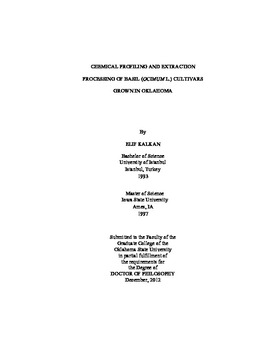| dc.contributor.advisor | Maness, Niels O. | |
| dc.contributor.author | Kalkan, Elif | |
| dc.date.accessioned | 2013-11-26T08:30:03Z | |
| dc.date.available | 2013-11-26T08:30:03Z | |
| dc.date.issued | 2012-12 | |
| dc.identifier.uri | https://hdl.handle.net/11244/7128 | |
| dc.description.abstract | Scope and Method of Study: The objectives for this study were to develop a chemical profile library for basil cultivars with potential production in Oklahoma while optimizing handling conditions for their dehydration processing as well as to evaluate and optimize ambient temperature extraction process (ATE) with propane for dehydrated basils. From 2005 to 2011, foliage harvests were intermittently conducted from sixteen cultivars prior to excessive flowering starting in early July and ending in late September at three to four week intervals, but in 2011 harvest frequency was varied on strict 2 week or 3 week intervals for five cultivars. Samples were typically dried at 40C after harvest. For ATE, dried samples were separated into flowers, leaves and stems. Extractions were then conducted using a custom built continuous flow propane extractor at ambient temperature (21-27C) and low pressure (1.1-1.9 MPa). Dried samples were ground before extracting with hexane while extracts were solubilized into hexane to identify and quantify aromatic chemical components using gas chromatography. Tristimulus L*, a* and b* values were used to calculate chroma, hue angle and browning index (BI) color attributes of �Sweet Thai� components. | |
| dc.description.abstract | Findings and Conclusions: Based on chemotype, the cultivars could be separated into three categories; the pesto type basils, such as �Genovese�, �Napolitano� and �Italian Large Leaf�, featuring linalool and eugenol, the spice-type basils, such as �Ethiopian Mint�, �Blue Spice� and �Sweet Thai� featuring eugenol and methyl chavicol and the citrus flavored basils, such as, �Mrs. Burns� Lemon� and �Lime�, featuring geranial and neral. The absolute herb yields, impact chemical concentrations, and total phytochemical production of basil cultivars were affected by the year, time of harvest within a year and the frequency of harvests. Spice type basils were more prone to exhibit changes in concentrations of impact chemicals than the pesto and citrus types. Drying at 40� C and careful handling, especially for cultivars including eugenol/linalool as major chemicals, was suggested to avoid excessive changes in aroma and aromatic intensity. Propane extraction appears to be feasible for dry basils. Cultivars differed in extraction kinetics, probably due to prevalence of trichome type for the cultivar. For �Sweet Thai�, extraction duration of 30 min should result in optimum extraction of aromatic chemicals, but extraction durations for other cultivars should be studied to optimize their process. | |
| dc.format | application/pdf | |
| dc.language | en_US | |
| dc.rights | Copyright is held by the author who has granted the Oklahoma State University Library the non-exclusive right to share this material in its institutional repository. Contact Digital Library Services at lib-dls@okstate.edu or 405-744-9161 for the permission policy on the use, reproduction or distribution of this material. | |
| dc.title | Chemical profiling and extraction processing of basil (Ocimum L.) cultivars grown in Oklahoma | |
| dc.contributor.committeeMember | McGlynn, William | |
| dc.contributor.committeeMember | Smith, Michael | |
| dc.contributor.committeeMember | Bowser, Tim | |
| osu.filename | Kalkan_okstate_0664D_12309.pdf | |
| osu.accesstype | Open Access | |
| dc.type.genre | Dissertation | |
| dc.type.material | Text | |
| dc.subject.keywords | basil | |
| dc.subject.keywords | chemical | |
| dc.subject.keywords | extraction | |
| dc.subject.keywords | processing | |
| dc.subject.keywords | propane | |
| dc.subject.keywords | volatile | |
| thesis.degree.discipline | Food Science | |
| thesis.degree.grantor | Oklahoma State University | |
